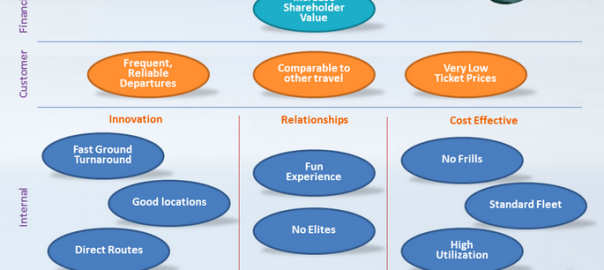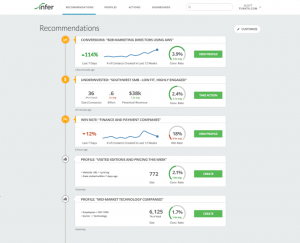If you’re looking for a good strategic management framework, you’ve most likely come across the Balanced Scorecard (BSC). It was created by Drs. Robert S. Kaplan and David P. Norton in 1992—over 20 years ago. So, you’re likely wondering, “Is it still relevant?”
I’ll cut right to the chase: the answer is a resounding yes.
In fact, it remains one of the top-performing frameworks in use today—and according to the 2015 Bain & Company Management Tools Study, it has made the list of the top 10 most popular tools for several years in a row now. But maybe your boss or leadership team just isn’t buying into it.
If this is the case, you’ll need some factual data and evidence to present. So, I’ve done that work for you. The following six points act as a solid justification for using the Balanced Scorecard, and why it’s just as important—if not more important—than it was when it was created 20+ years ago.
#1: It ties directly to the number one issue of executives today: strategy execution.
At the Association of Strategic Planning (ASP) conference this year, I gave a talk on this topic. I feel that it’s more important to have a bad strategy executed well than it is to have a good strategy executed poorly. Even if you execute a terribly-planned strategy, you at least have the ability to understand what went wrong, fix it, and learn from your mistakes. An excellent strategy that is left “on the shelf” might look nice, but it’ll do absolutely nothing as far as furthering your goals are concerned.
So, simply having a Balanced Scorecard (or any other strategic framework, for that matter) won’t help you execute your strategy. But if you get leadership buy-in and support during the integration process and continue to foster and develop the framework, it’ll help you make the clear strategic decisions your organization needs in a more effective way.
#2: It provides a framework to align everyone in the organization around a mission and vision.
When the Balanced Scorecard was created, it didn’t have much to do with strategy mapping; but over the years, it has become an integral and unique part of the framework. A strategy map is a one-page, visual representation of an organization’s strategy that works to tell a story. This method allows your organization to consistently view, and therefore focus on, your most critical goals and objectives.
Below is a sample strategy map from Upward Air (a fictitious company); it’s loosely based on Southwest Airlines’ strategy in the early 2000s. It lists, from top to bottom, the most important organizational objectives, organized into the four BSC pillars—Financial, Customer, Internal, and Learning & Growth:

#3: It allows organizations to be more responsive to changes in the competitive landscape.
Leading indicators—the nonfinancial measures on a scorecard—help your company look forward and predict future performance. In other words, tracking leading indicators can help you respond to an array of issues before they actually become problems. For example, you might see sales in a particular region dropping, signaling the entry of a new competitor. Tracking Balanced Scorecard measures allows you to address this strategic threat head-on before it makes a major impact on your profits.
#4: It provides quantifiable metrics that show the health of an organization.
Age-old wisdom and common sense both tell us that if something isn’t measured, it won’t be managed. But the act of selecting just any key performance indicators (KPIs) doesn’t help ensure a better strategy. In fact, measures can drive a bad strategy just as quickly as they can drive a good one!
So how do you remedy this? By selecting measures that tie to one of your overall objectives—ones that are directly linked to your strategy. Don’t just take my word for it; a 2008 study found field-based evidence that the Balanced Scorecard is useful in detecting—and therefore fixing—problems with a strategy. The moral here is that measures alone won’t ensure your strategic success, but intelligently-selected measures will.
#5: It helps drive transparency.
Organizations that excel at strategic implementation aren’t afraid of exposing their strategy. Balanced Scorecard strategy maps are perfect for publishing, as they help prove to shareholders, constituents, or citizens that you’re on a direct strategic path.
These companies know that in order to win, they need to execute—and part of that execution includes being transparent. Take Mobil NAM&R, for example. This multi-billion dollar division of Exxon Mobil is one of the most noteable Balanced Scorecard success stories. Because of the transparency of their process, it was highlighted in The Strategy-Focused Organization, a BSC case-study text put out by Kaplan and Norton.
Local governments are using their version of the Balanced Scorecard to drive transparency with their citizens as well. Charlotte-Mecklenburg was an early adopter of the process, but cities like Durham, NC, Charlottesville, VA, and Vaughan, ON are using their version of a scorecard to report out to citizens, as well.
#6: It links projects to measures, and measures to strategy.
A lot of people have separated project management and strategic measurement. But frankly, that’s a mistake. Projects are how things get done in organizations, so that’s where budgets are allocated. The Balanced Scorecard remedies this by explicitly linking measures to strategic objectives, and linking initiatives or projects to the strategy, as well. Strategic initiatives are those critical projects that “close the gap” on measures that are underperforming.
By linking your projects to your strategy, you can gain visibility into the actions your organization is taking to improve its measures. It can also help to show where you have a true lack of alignment in your organization.
Bonus Reason #7: You can make it yours.
The biggest reason that the Balanced Scorecard has been so popular and successful for so many years is because it continues to be a proven framework organizations use to organize their various strategies. For example, if your strategy is to embrace “big data,” the Balanced Scorecard can act as a gateway for your company to achieve that goal. If you use Six Sigma or TQM, the Balanced Scorecard can also help with that. If you run global franchises or a small storefront, the Balanced Scorecard is very useful.
The BSC is a “framework for frameworks.” You can take your best practices and approaches and integrate them into a scorecard, and the end product will be a fully-customized solution that suits all of your needs. You can use the BSC to drive operational excellence, customer intimacy, product innovation, or whatever else is important to you. The beauty of this framework is in its simplicity—it distills business basics into an easy-to-use system that everyone can understand and work with.
So while the BSC may be a millennial-aged framework, it isn’t dead. In fact, it isn’t even outdated. It is still an extremely relevant, useful tool that thousands of organizations around the world are highly satisfied with.
To quote David Norton, the originator (and thought leader) of the Balanced Scorecard concept, the BSC is the “chart of accounts for strategy.” I couldn’t say it any better myself.
(408)







